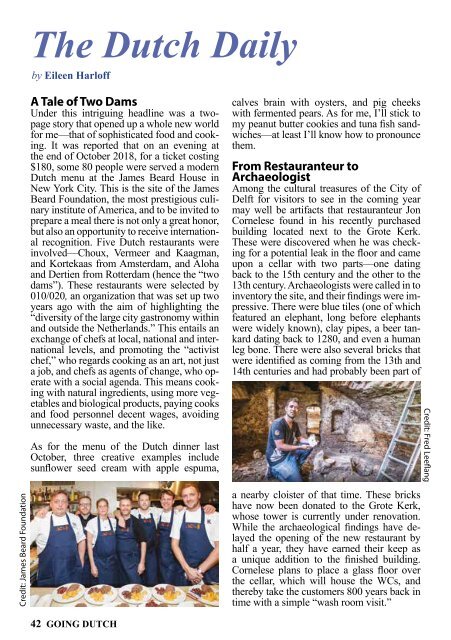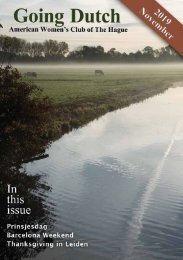AWC Going Dutch January_February 2019
American Women's Club of The Hague monthly magazine
American Women's Club of The Hague monthly magazine
Create successful ePaper yourself
Turn your PDF publications into a flip-book with our unique Google optimized e-Paper software.
The <strong>Dutch</strong> Daily<br />
by Eileen Harloff<br />
A Tale of Two Dams<br />
Under this intriguing headline was a twopage<br />
story that opened up a whole new world<br />
for me—that of sophisticated food and cooking.<br />
It was reported that on an evening at<br />
the end of October 2018, for a ticket costing<br />
$180, some 80 people were served a modern<br />
<strong>Dutch</strong> menu at the James Beard House in<br />
New York City. This is the site of the James<br />
Beard Foundation, the most prestigious culinary<br />
institute of America, and to be invited to<br />
prepare a meal there is not only a great honor,<br />
but also an opportunity to receive international<br />
recognition. Five <strong>Dutch</strong> restaurants were<br />
involved—Choux, Vermeer and Kaagman,<br />
and Kortekaas from Amsterdam, and Aloha<br />
and Dertien from Rotterdam (hence the “two<br />
dams”). These restaurants were selected by<br />
010/020, an organization that was set up two<br />
years ago with the aim of highlighting the<br />
“diversity of the large city gastronomy within<br />
and outside the Netherlands.” This entails an<br />
exchange of chefs at local, national and international<br />
levels, and promoting the “activist<br />
chef,” who regards cooking as an art, not just<br />
a job, and chefs as agents of change, who operate<br />
with a social agenda. This means cooking<br />
with natural ingredients, using more vegetables<br />
and biological products, paying cooks<br />
and food personnel decent wages, avoiding<br />
unnecessary waste, and the like.<br />
As for the menu of the <strong>Dutch</strong> dinner last<br />
October, three creative examples include<br />
sunflower seed cream with apple espuma,<br />
calves brain with oysters, and pig cheeks<br />
with fermented pears. As for me, I’ll stick to<br />
my peanut butter cookies and tuna fish sandwiches—at<br />
least I’ll know how to pronounce<br />
them.<br />
From Restauranteur to<br />
Archaeologist<br />
Among the cultural treasures of the City of<br />
Delft for visitors to see in the coming year<br />
may well be artifacts that restauranteur Jon<br />
Cornelese found in his recently purchased<br />
building located next to the Grote Kerk.<br />
These were discovered when he was checking<br />
for a potential leak in the floor and came<br />
upon a cellar with two parts—one dating<br />
back to the 15th century and the other to the<br />
13th century. Archaeologists were called in to<br />
inventory the site, and their findings were impressive.<br />
There were blue tiles (one of which<br />
featured an elephant, long before elephants<br />
were widely known), clay pipes, a beer tankard<br />
dating back to 1280, and even a human<br />
leg bone. There were also several bricks that<br />
were identified as coming from the 13th and<br />
14th centuries and had probably been part of<br />
Credit: Fred Leeflang<br />
Credit: Museum Mondial<br />
Miniatures at Their Minimalist<br />
They were created in the Soviet era. They<br />
require a microscope to see and recognize<br />
them. They are few in number. They are<br />
unique and truly spectacular. They are 14<br />
of the many miniatures created by Mykola<br />
Syadristy, a well-known artist in his home<br />
country of the Ukraine. They are on display<br />
in Museum Mondial in Volendam, which<br />
was created especially for this purpose after<br />
a visit that Mural Bilan made to an exhibition<br />
of Syadristy’s work in Turkey. What<br />
he saw astonished and impressed him, and<br />
he enthusiastically told his neighbor in the<br />
Netherlands, Marc van Hartog, who was<br />
then Director of the Stedelijk Museum in<br />
Zwolle. He too was impressed, and an exhibition<br />
was arranged in his museum. In the<br />
meantime, Bilan and van Hartog envisioned<br />
a museum dedicated to just the works of<br />
Syadristy, who agreed to the plan if he himself<br />
could select its location. The three men<br />
visited many sites and finally, in the small<br />
town of Volendam, the artist chose a site on<br />
items on display are portraits of Rembrandt<br />
and Yuri Gagarin, the first person in space,<br />
a bug on a foot and a 1.8 millimeter beautifully<br />
detailed windmill. The materials used<br />
by the artist are pliable gold and fruit pits.<br />
The history of the artist is as fascinating as<br />
his works. Born in 1937 in Ukraine, then a<br />
part of Russia, he was an engineer by career<br />
and a diver for sport. As such, he learned to<br />
slow down his breathing, which stood him<br />
in good stead in his art, whereby a slight<br />
trilling of the hand could lead to the destroying<br />
of a work in progress. The KGB—<br />
the Russian Secret Service—wanted to<br />
recruit him to make miniature devices for<br />
listening in on people’s conversations, but<br />
he refused and as a result he was arrested<br />
and tortured. Fortunately, he survived and<br />
has become a well-known artist. Museum<br />
Mondial is open Tuesday to Sunday, from<br />
10 a.m. to 6 p.m.<br />
The Last Post Office<br />
In November the only remaining post office<br />
in The Hague was closed. The era of<br />
the local post office, with the head office<br />
next to the Grote Kerk in the center of town,<br />
is over. They have been replaced by neighborhood<br />
postal agencies in stores, tobacconists,<br />
and supermarkets. One of the most<br />
unusual of these locations is situated across<br />
the street from the former central office and<br />
is in the shop Papegaaien Paleis, or Parrot<br />
Palace. Here can be found some 300 parrots<br />
of various colors, attributes and countries<br />
of origin. As the owner of the Palace<br />
says, “nowhere else in the Netherlands can<br />
you buy stamps or send packages among<br />
parrots” and, incidentally, you may even be<br />
prompted to buy one.<br />
Credit: James Beard Foundation<br />
a nearby cloister of that time. These bricks<br />
have now been donated to the Grote Kerk,<br />
whose tower is currently under renovation.<br />
While the archaeological findings have delayed<br />
the opening of the new restaurant by<br />
half a year, they have earned their keep as<br />
a unique addition to the finished building.<br />
Cornelese plans to place a glass floor over<br />
the cellar, which will house the WCs, and<br />
thereby take the customers 800 years back in<br />
time with a simple “wash room visit.”<br />
the harbor, with a beautiful view. And so<br />
Museum Mondial was established.<br />
Syadristy loaned the 14 works to the museum.<br />
Among this collection is a gold replica,<br />
3.85 millimeters small and containing<br />
256 details, of the Santa Maria, the lead<br />
ship that Christopher Columbus sailed to<br />
America. Syadristy commanded that this<br />
work of art should be so placed in the museum<br />
that it looked out over the harbor. Other<br />
Credit: Parrot Palace<br />
42 GOING DUTCH<br />
JANUARY/FEBRUARY <strong>2019</strong> 43

















